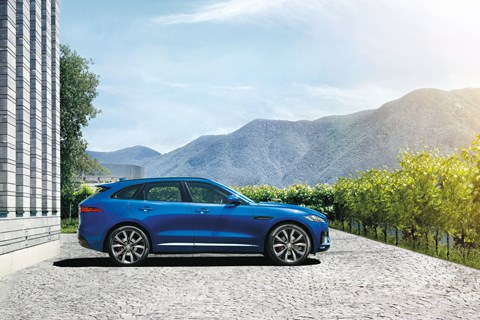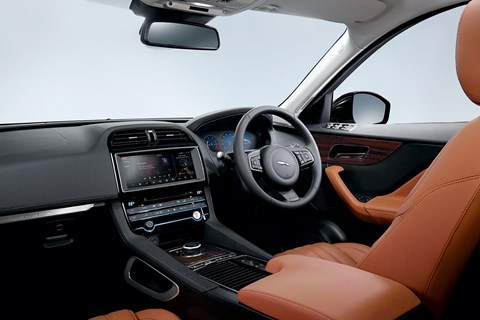► Jaguar F-Pace SUV revealed in full
► Revealed in record loop-the-loop stunt
► Prices start from £34,170 in the UK
This is the new Jaguar F-Pace, finally revealed in full ahead of its global debut at the 2015 Frankfurt motor show. Its reveal was accompanied by a record-breaking publicity stunt, with an F-Pace achieving a Guinness world record for the largest ever loop-the-loop achieved by a car. (See the video at the foot of the page to watch stunt driver Terry Grant’s gravity-defying record run.)
No surprises on the styling front. As predicted, the F-Pace has barely wavered from the visual blueprints laid down by the C-X17 concept car of 2013. Jaguar hasn’t changed its tune about the F-Pace’s handling credentials either, describing its new creation as ‘a performance crossover for those who love driving, with unrivalled dynamics.’ Could the F-Pace really topple Porsche’s Macan as the sportiest SUV out there?
What’s more, Jaguar’s gone for an aggressive pricing strategy – UK prices start from a really rather competitive £34,170, with orders already open.
Jaguar F-Pace: engines and trims
Three engines are available from launch. The range kicks off with Jaguar Land Rover’s 178bhp 2.0-litre four-cylinder Ingenium diesel, available with either rear or four-wheel drive, with a choice of six-speed manual or eight-speed auto transmissions. Opting for rear-drive (which is available with a manual gearbox only) gives you the lowest CO2 emissions of the range, at 129g/km.

All other F-Paces are 3.0-litre V6-powered, with a choice of a 296bhp diesel (47.1mpg, 159g/km) or the 375bhp supercharged petrol also found in the F-type (31.7mpg, 209g/km). Both are 4wd and eight-speed auto only.
The petrol supercharged F-Pace is a genuinely fast car in any book, SUV or otherwise, capable of 0-60mph in 5.1sec and an electronically limited top speed of 155mph. The V6 diesel’s not so shabby either, getting from 0-60mph in 5.8sec, and on to a top speed of 150mph. Could there be a 5.0-litre supercharged V8 option sometime in the future? We could well imagine Coventry signing off an SVO model to cement the model’s dynamic focus.
Four model lines make up the F-Pace range from launch: Prestige (from £34,170), R-Sport (from £36,670), Portfolio (from £39,170), and S (from £51,450), all with five doors and five (leather) seats.
There’s also a limited-run First Edition, available during the first year of production only at a substantial £65,275. With similar metallic blue paintwork and houndstooth-patterned seat upholstery to the original C-X17 concept, the First Edition’s available only with the 3.0 V6 diesel engine.
Inside the F-Pace
No surprises here either. The interior’s more than a little reminiscent of the XE and XF, with a similar wraparound ‘gunwale’ encircling the doors and dashboard, rotary gear selector on automatic models and a digital instrument cluster. The latter can be switched between various display themes, including a full-screen 3D sat-nav display, TT-style.
All models get an enormous 10.2-inch touchscreen as standard, operating a multimedia system Jaguar calls ‘InControl Touch Pro.’ Not least in its bag of tricks is the ability to connect up to eight devices to a wi-fi hotspot within the car.
Rear passengers can enjoy knee-room Jaguar describes as class-leading, and behind them there’s a really quite cavernous 650-litre boot.

Jaguar F-Pace: the chassis story
Built at JLR’s Solihull factory alongside the Jaguar XE, the F-Pace is underpinned by a development of the same aluminium-intensive platform as the XE and XF, with double-wishbone suspension at the front and an integral link rear.
Torque vectoring’s standard, and electronically controlled adaptive dampers are an option, with drivers able to fine-tune their own settings for throttle response, transmission, electric power steering and the dampers via the F-Pace’s Configurable Dynamics menu.
In line with the sporty driving pitch, four-wheel drive versions send the majority of their torque to the rear wheels, although as much as 50% can be directed to the front when called for. Adaptive Surface Response (ASR), a variation on Land Rover’s Terrain Response system, meters torque out precisely on loose ground to help find traction and includes a mode for deep snow and gravel. There are plenty of other traction-aiding acronyms on hand as well. Below 19mph on very slippery surfaces there’s All Surface Progress Control (ASPC), a kind of low-speed cruise control that automatically controls the throttle and brakes while the driver takes care of the steering, and for similar situations there’s Low-Friction Launch (LFL), a kind of ultra-progressive throttle map.
Jaguar is adamant the F-Pace will be the ‘most rewarding driver’s car of its kind.’ Please don’t disappoint us, Jaguar!